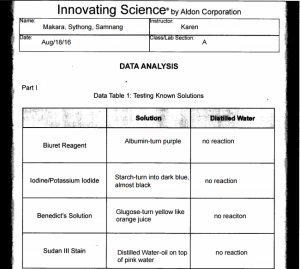All living organisms need nutrients to survive. Some organisms can produce their own nutrients and some are not like human. They don’t have that ability, so they must consume nutrients from outside resources. Nutrients are basically classified into six groups: carbohydrates, proteins, lipids, vitamins, minerals, and water.
Testing for Nutrients
There are several ways to test the food to see if they have these nutrients: proteins, carbohydrates, and lipids. One method that my class did is to use the chemical indicators. Chemical indicators are substance that gives a visible sign, usually by a color change. So, we put four kinds of chemical into our food.These are the chemical indicators:
Biuret reagent – a chemical that can be used to highlight proteins. It is a light blue solution that when come to contact to proteins, it will turn to dark blue.
Benedict’s solution – a light blue solution, and when combined with a monosaccharide (and most disaccharides) and heated, it will change the color. The color may be a bit yellowish or light orange after heating. A green to yellow show that it contain a small amount of sugar and an orange or red color indicates that it has more sugar.
Iodine/Potassium iodide (IKI) – can be used to test for polysaccharide starch. A yellow/brown solution, IKI will turn deep blue to black when come in contact with starch.
Sudan III – a fat-soluble dye, and if it combines with a substance containing lipids, the dye will build up in the lipids, staining the lipids red.
Source from Innovating Science by Aldon Corporation
Data Analysis – testing to see what happen after adding the chemical indicator to the solution
Data Analysis – testing to see if the food has protein, starch, sugar, and lipid or not



